Click here and press the right key for the next slide (or swipe left)
also ...
Press the left key to go backwards (or swipe right)
Press n to toggle whether notes are shown (or add '?notes' to the url before the #)
Press m or double tap to slide thumbnails (menu)
Press ? at any time to show the keyboard shortcuts

\def \ititle {Lecture 03}
\def \isubtitle {Joint Action}
\begin{center}
{\Large
\textbf{\ititle}: \isubtitle
}
\iemail %
\end{center}
Today’s lecture is about Michael Bratman’s account of shared agency, focussing on
what he says about shared intention.
I think it’s worth spending some time with Bratman’s account because
his is the leading, best developed account.
Although I do want to argue that he is wrong in some major respects about
shared intention, no one else has published a good objection to his acocunt.
You could say that he is currently the undefeated champion, at least for now.
And even if you end up agreeing with me that Bratman’s account is wrong, it
is almost certain that you will be influenced by his ideas in some way or another
when constructing an alternative account.
\section{Shared Intention: A Placeholder}
Most philosophers agree that a notion of shared intention is needed
to characterise shared agency. The idea is that shared intention
stands to joint action as ordinary, individual
intention stands to ordinary, individual action.
But what is shared intention?

Recall our question, What distinguishes joint actions from parallel but merely individual actions?

‘A first step is to say that what distinguishes you and me from you and the Stranger is that you and
I share an intention to walk together—we (you and I) intend to walk together—but you and the Stranger
do not. In modest sociality, joint activity is explained by such a shared intention; whereas no such
explanation is available for the combined activity of you and the Stranger. This does not, however,
get us very far; for we do not yet know what a shared intention is, and how it connects up with joint
action’ \citep[p.~152]{Bratman:2009lv}.
‘A first step is to say that what distinguishes’ the sisters cycling together from the strangers cycling side by side is that the sisters share an intention to cycle together ... but the strangers do not.
‘In modest sociality, joint activity is explained by such a shared intention; whereas no such explanation is available for the combined activity’ of those who are acting in parallel but merely individually.
‘This does not, however, get us very far; for we do not yet know what a shared intention is’
Bratman, 2009 p. 152
Lots of philosophers and some psychologists think that all joint actions involve
shared intention, and even that characterising joint action is fundamentally a matter
of characterising shared intention.
‘I take a collective action to involve a collective [shared] intention.’
\citep[p.~5]{Gilbert:2006wr}
(Gilbert 2006, p. 5)
‘The sine qua non of collaborative action is a joint goal [shared intention] and a joint commitment’
\citep[p.~181]{tomasello:2008origins}
(Tomasello 2008, p. 181)
‘the key property of joint action lies in its internal component [...] in the participants’ having
a “collective” or “shared” intention.’
\citep[pp.~444--5]{alonso_shared_2009}
(Alonso 2009, pp. 444-5)
‘Shared intentionality is the foundation upon which joint action is built.’
\citep[p.~381]{carpenter:2009_howjoint}
(Carpenter 2009, p. 381)
Parallel with individual action ...
It is helpful to draw a parallel with individual action ...
Consider Davidson’s question
‘What events in the life of a person reveal agency; what are his deeds and his
doings in contrast to mere happenings in history; what is the mark that
distinguishes his actions?’
Davidson (1971, p. 43)
\citep[p.~43]{Davidson:1971fz}
It is perhaps helpful to think of this question by contrasing actions with
things that merely happen to an agent.
To illustrate, we might be struck by the contrast between your arm being caused to go
up by forces beyond your control, and the action you perform when you raise your arm.
Or we might be struck by the contrast between mere reflexes, such as the eyeblink reflex,
and the action of blinking your eyes (perhaps to greet someone).
‘Echoing Wittgenstein's question about the difference, in the individual case,
between my arm's rising and my raising it, we can ask: what is the difference
between such a contrast case and corresponding shared intentional activity?
In the case of individual intentional human action, we can see the difference from
a contrast case as involving an explanatory role of relevant intentions of the
individual agent. ... I propose an analogous view ofthe shared case: the difference
in the case of shared agency involves an appropriate explanatory role of relevant
shared intentions. Our painting together is a shared intentional activity,
roughly, when we paint together because we share an intention so to act.’
\citep[p.~10]{bratman:2014_book}

In short, Davidson’s question is, Which events are actions?
Suppose we ask, Which events are actions?
(This is Davidson’s question.)
Here the contrast is with things that merely happen to an agent.
To illustrate, we might be struck by the contrast between your arm being caused to go
up by forces beyond your control, and the action you perform when you raise your arm.
Or we might be struck by the contrast between mere reflexes, such as the eyeblink reflex,
and the action of blinking your eyes (perhaps to greet someone).

One quite natural and certainly influential way to answer this question is by
appeal to intention. The idea is that events are actions in virtue of being
appropriately related to an intention of yours.
Note that I’m not confidently endorsing this answer; in fact I’m not even
confident that the question is ultimately the right question to ask.
I’m just suggesting this is a reasonably straightforward starting point for us.

This question about ordinary, individual action is parallel to our current working
question about joint action, which we might phrase as ‘Which events are *joint* actions’ ...
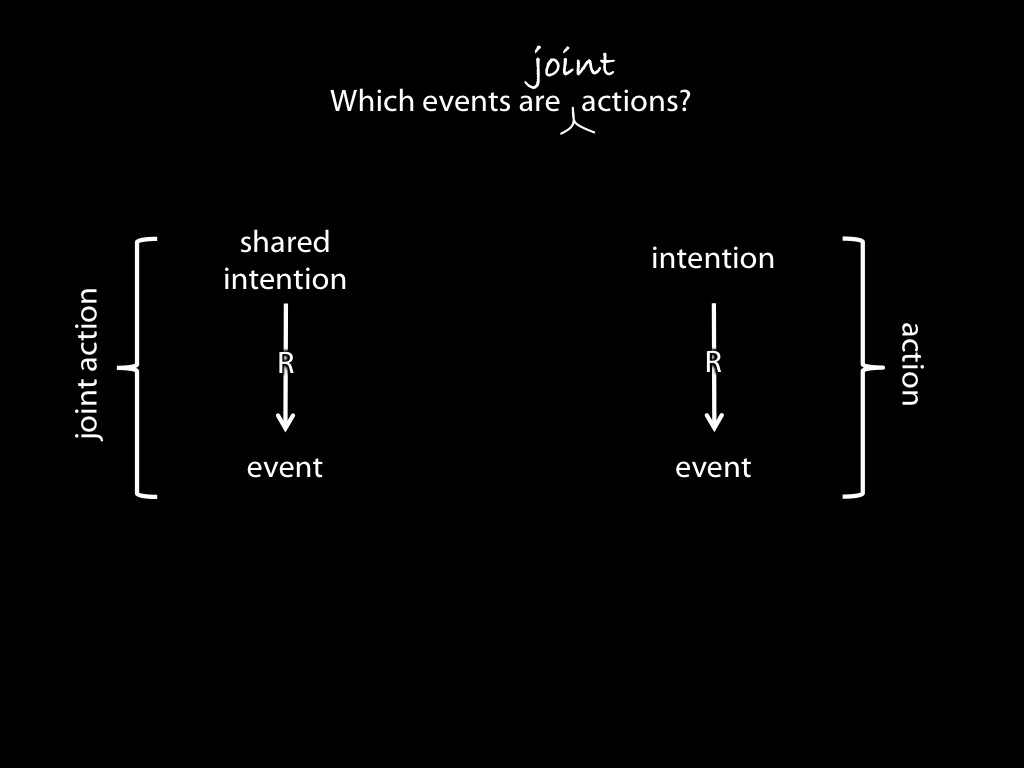
Now we can see one attraction of appealing to shared intention.
It allows us to give a parallel answer to the question about joint action:
a joint action is an event which is appropriately related to a shared intention.
So to the extent that we are persuaded by the standard account of which events are actions,
it is natural to aim for a structurally parallel account of which events are joint actions.
To do this we merely have to characterise shared intentions.
As we shall see, there are long running, deep conflicts over the nature of shared
intention. The range of different approaches can be quite daunting.
This parallel between intention and shared intention is important because it is
a rare point on wihch almost everyone will agree.
\textbf{Despite the disagreement on details, I think one thing almost everyone agrees about
is this: shared intention is to joint action at least approximately what
ordinary individual intention is to ordinary, individual action.}

It’s important to acknowledge that we haven’t yet said anything very informative
about what shared intention is.
The question was, Which events are joint actions?
The answer was, those which stand in an appropriate relation to a shared intention.
Then we ask what a shared intention is.
And the answer is, it’s something in virtue of which events are joint actions.
I don’t think the circle makes this completely useless;
but I’m mentioning the circularity to stress that we don’t yet have an account
of what shared intention is.
An account of shared intention should to provide deep insight
into the nature of shared agency.
shared intention
So we still need an account of what shared intention is.
But first, why not try taking the term literally?
...
\section{Why Not Take ‘Shared Intention’ Literally?}
On most accounts, shared intentions are neither shared nor intentions.
But why not take the term literally?
Intentions can be shared in the sense in which Ayesha and her best friend share a name.
(This would yield a version of the Simple View.)
Or perhaps they can be shared in the sense in which Ayesha and her broth share a mother.
‘shared’ 1 : Ayesha and her best friend have the same haircut
-> the Simple View
‘shared’ 2 : Ayesha and her brother share a mother
-> plural subject account (Schmid, Helm)
Let’s try to understand, in really minimal terms, what the plural subject
account is saying ...
For comparison, properties like mass and volume can have plural subjects.
e.g. our volume, yours and mine, is approx 130 litres.
cf. our intention, yours and mine, is that we paint the house.

To understand the plural subject account, consider the formal features of mental states.
Here is a desire ...
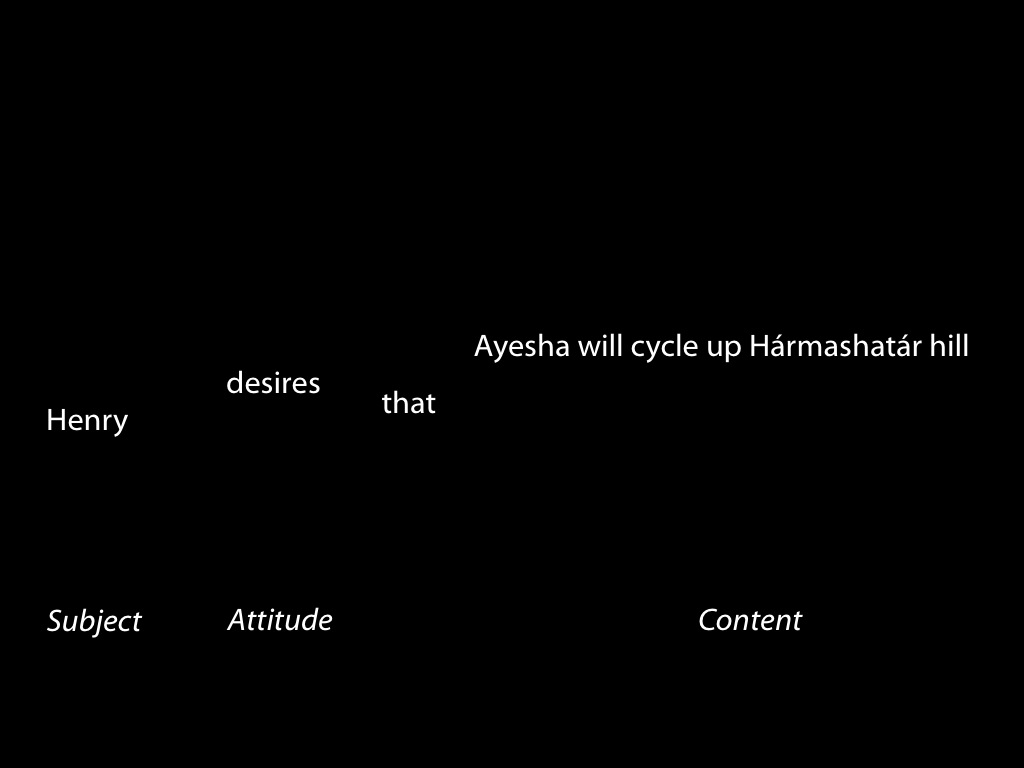
The desire has three parts, subject, attitude and content.

The subject is you or me or whoever.
(The subject might not be the agent but some part of it.
That is, we can imagine that some component of an agent, like her perceptual system or
motor system, represents things that she herself does not.)

The attitude is labelled ‘belief’ or whatever.
These are usually distinguishes by their causal, explanatory and normative roles.
Roughly, what makes a *belief* that Ayesha will cycle up Hármashatár hill different
from a *desire* that Ayesha will cycle up Hármashatár hill is that these two things
will have different effects on the subject’s actions.
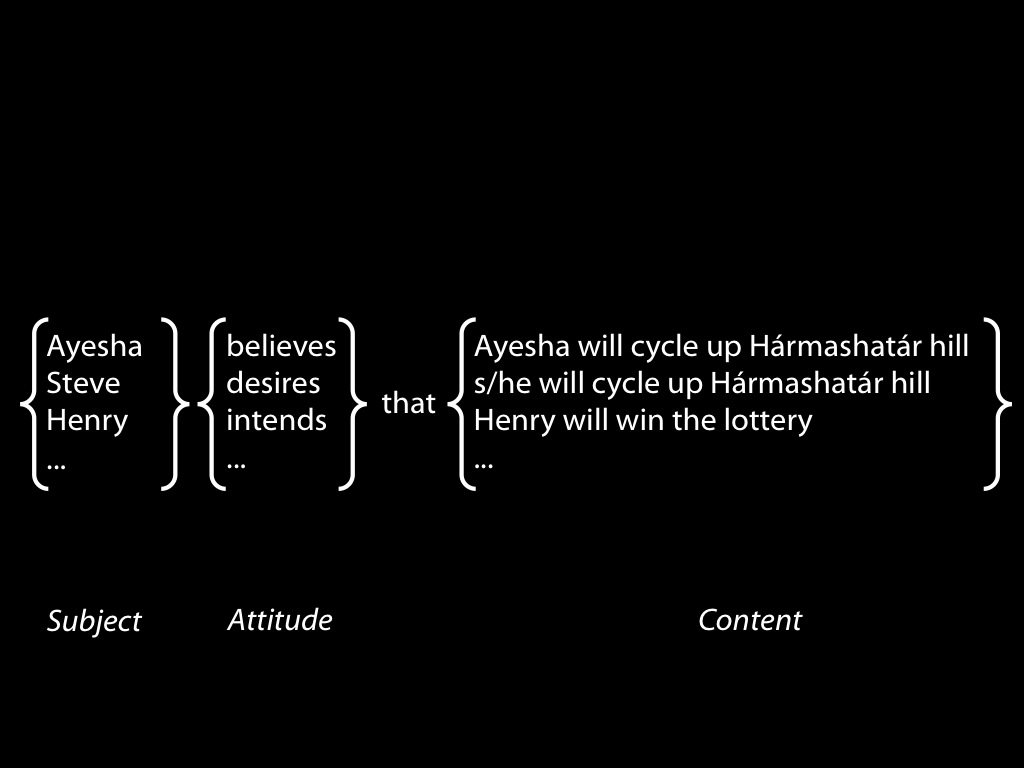
The content is what distinguishes one belief from all others, or one desire from all others.
The content is also what determines whether a belief is true or false, and whether a
desire is satisfied or unsatisfied.
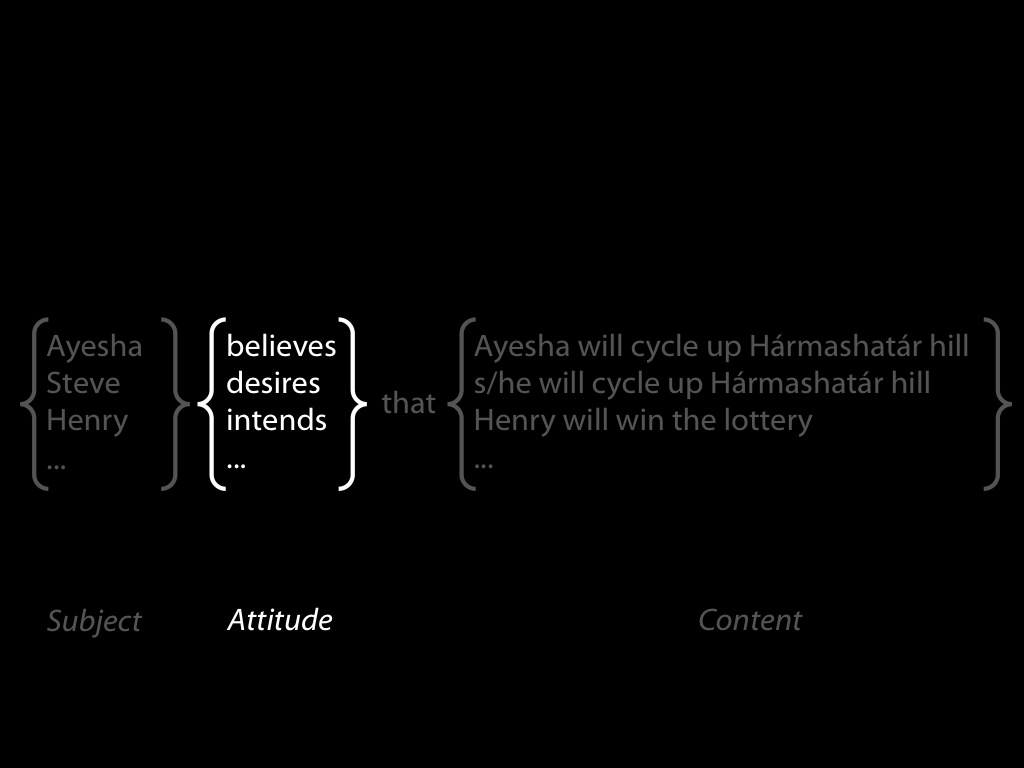
There are two main tasks in constructing a theory of mental states.
The first task is to characterise the different attitudes.
This typically involves specifying their distinctive functional and normative roles.
The second task is to find a scheme for specifying the contents of mental states.
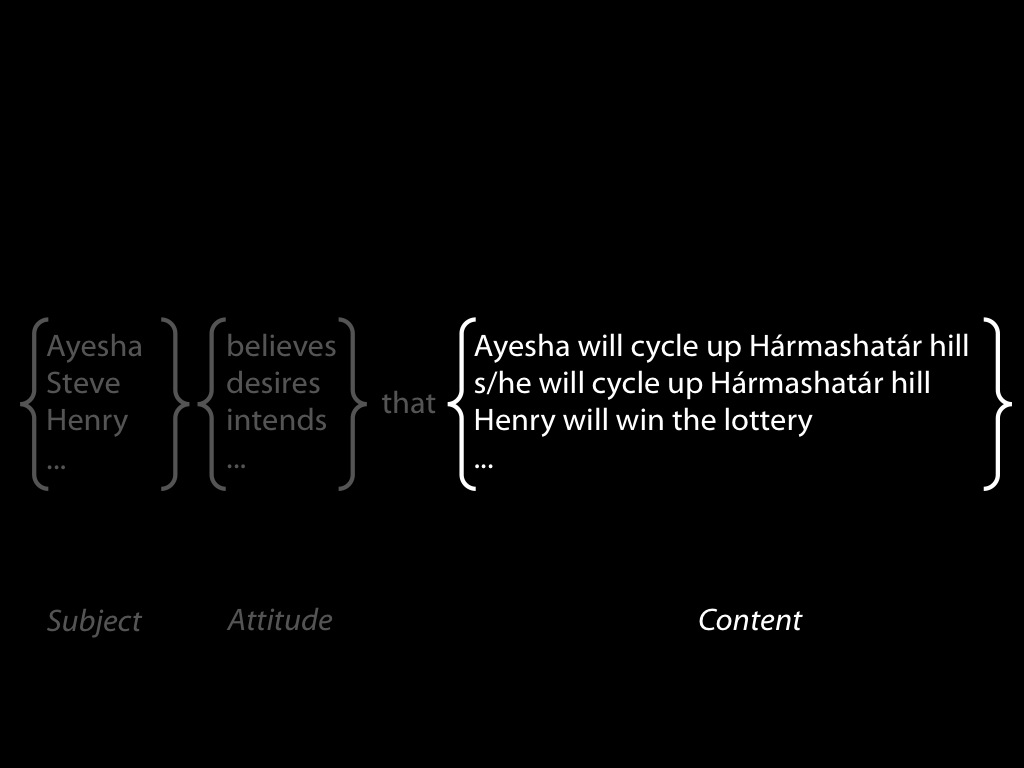
The second task is to find a scheme for specifying the contents of mental states.
Usually this is done with propositions (and we don’t need to worry about that here).

Most philosophers think that shared intention is special with respect to at least
one of subject, attitude and content. However they disagree on which, and how.
Corresponding to each of the three things--subject, attitude and content--there are
different strategies for trying to explain shared intention.
Strategies for explaining shared intention:
\begin{enumerate}
\item mess with the subject \citep[e.g.][]{helm_plural_2008,Schmid:2008,schmid:2009_plural_bk,pettit:2006_joint}
\item mess with the attitude \citep[e.g.][]{Searle:1990em,gallotti:2013_social}
\item mess with the content \citep[e.g.][]{Bratman:1993je,bratman:2014_book}
\item mess with all three \citep[e.g][]{gilbert:2014_book}
\end{enumerate}

So one strategy for explaining shared intention is to try messing with the subject.
I think this is potentially interesting, whether or not it gives us shared intention.
‘shared’ 1 : Ayesha and her best friend share a name
-> the Simple View
‘shared’ 2 : Ayesha and her brother share a mother
-> plural subject account
So I’ve tried to explain, in really minimal terms, what the plural subject
account is saying ...
We’ll come back to it later.
But for not I want to assume that we cannot take the term ‘shared intention’ literally.
On most accounts,
shared intentions are neither shared nor intentions.
Can intentions have
plural subjects?
My thought: to answer this question we have to step back and ask,
What anchors our thinking about intention?
It’s not hard to imagine answers which allow the subjects of intention
to be plural.
shared intention
Our current status is this: the failure of the Simple View and other simple,
initially attractive ideas about what joint action is indicates that we
need to consider full-blown theories about the nature of joint action.
These are mostly accounts of shared intention, so I wanted to start by trying
to anchor our understanding of what shared intention is by offering a point
on which nearly everyone agrees.
(The point of agreement is this: shared intention is to joint action at least approximately what
ordinary individual intention is to ordinary, individual action)
So still need an account of what shared intention is.
The first account we will look at in detail is Michael Bratman’s (well you cover
Searle in the seminar so I don’t need to say much about that here).
But first I want to step back
and cover some basics about the nature of intention very quickly.
This will give us a sense of the options for constructing accounts of shared intention.

Recap: Bratman on Shared Intention
\section{Recap: Bratman on Shared Intention}
The leading, best developed account of shared intention is due to Michael Bratman.
Here we recall the main features of his account.
the continuity thesis
‘once God created individual planning agents and ... they have relevant knowledge of each
other’s minds, nothing fundamentally new--conceptually, metaphysically, or normatively--needs
to be added for there to be modest sociality.’
Bratman (2015, p. 8)
\citep[p.~8]{bratman:2014_book}
What is shared intention?
Functional characterisation:
shared intention serves to (a) coordinate activities,
(b) coordinate planning, and
(c) structure bargaining
Constraint:
Inferential integration... and normative integration (e.g. agglomeration)
Substantial account:
We have a shared intention that we J if
‘1. (a) I intend that we J and (b) you intend that we J
‘2. I intend that we J in accordance with and because of la, lb, and meshing subplans of la and lb; you intend [likewise] …
‘3. 1 and 2 are common knowledge between us’
(Bratman 1993: View 4)
Note that these conditions are offered as sufficient but not necessary.
(Bratman originally claimed that they were necessary and sufficient, but
nothing in the construction rules out alternative realisations of the functional
characterisation of shared intention.)
Are sufficient conditions sufficient for achieving Bratman’s aims?
Bratman’s pitch is this.
Recall the continuity thesis (‘once God created individual planning agents and ... they
have relevant knowledge of each other’s minds, nothing fundamentally new--conceptually,
metaphysically, or normatively--needs to be added for there to be modest sociality.’ p.8)
Bratman reasons that if we can give sufficient conditions for shared agency that
are consistent with the continuity thesis, then our default assumption should be that
shared agency does not require concepual, metaphysical or normative innovation.
So if we accept Bratman’s sufficient conditions, then we should also accept the
continuity thesis.
(There might issues about whether merely sufficient conditions are enough to fulfil his aim
of providing a framework for theorising about shared agency; more on this when we
come to consider joint action and development.)
Give an objection
to Bratman’s account!

A Counterexample to Bratman
\section{A Counterexample to Bratman}
No one has yet offered a convincing counterexample to Bratman’s account
of shared agency in print. I think there is one, though.
If successful, the counterexample
motivates considering alternative, more exotic approaches.
I want to start by considering an objection to Bratman which I think is misguided,
because seeing how this objection is misguided is the key to understanding
what is wrong with Bratman’s account.
Having a shared intention involves us each intending that we, you and I, φ together.
Bratman
‘Bratman’s account presupposes the element of sharedness it aims to explain.’
\citep[p.~36]{schmid:2009_plural_bk}
‘It is only because we intend J that I can have intentions of the form “I intend that we J”’
\citep[p.~36]{schmid:2009_plural_bk}
‘Bratman’s ... account of shared intentionality ... fails to give an account of the crucial element of collectiveness that is presupposed at its very base’
\citep[p.~37]{schmid:2009_plural_bk}
[The reply to Schmid is the people who block the asile, or the Tarantino walkers.]
Full quote:
‘Consider the following example. If we jointly intend to meet for lunch today, it does
not seem necessary – indeed it is redundant – for me to form an intention of the form
“I intend that we meet for lunch today” (rather, I will typically form some we-derivative
[Sellars 1980: 99] or participatory [Kutz 2000a] intention of the kind “I intend to call
you before noon to arrange a meeting place”). If and only if I take myself to be in a position
to have a say in that matter, I might form an additional intention that specifies the content
of our we-intention, and this additional intention might be of the form “I intend that we Jx”
(e.g., “I intend that we have lunch together at the Japanese restaurant”). But intentions of
this sort presuppose shared intentions instead of being their building blocks. It is only
because we intend J that I can have intentions of the form “I intend that we Jx”. Thus it
seems that Bratman’s “reductive” account of shared intentionality “in terms of attitudes
and actions of the individuals involved” (1999: 108) simply fails to give an account of
the crucial element of collectiveness that is presupposed at its very base, because he
endorses formal individualism.’
Schmid (2009, p. 36)
I think Schmid is wrong that Bratman’s presupposes collectiveness.
Quite the opposite: I think it fails to capture collectiveness.
So my objection takes a line opposite Schmid’s (and cannot be correct unless his
objection is wrong).
Functional characterisation:
shared intention serves to (a) coordinate activities,
(b) coordinate planning, and
(c) structure bargaining
We have a shared intention that we J if
‘1. (a) I intend that we J and (b) you intend that we J
‘2. I intend that we J in accordance with and because of la, lb, and meshing subplans of la and lb; you intend [likewise] …
‘3. 1 and 2 are common knowledge between us’
(Bratman 1993: View 4)

Blomberg (personal communication)
Ayesha and Beatrice are bitter rivals.
They each have one wrist handcuffed to the steering wheel of the same moving car.
They are matched in strength closely enough that neither can decide the car’s course alone:
its movements will be a consequence of both of their actions.
Ayesha, determined that Beatrice should die and wishing to die herself,
is wondering how she could bring this about.
Thinking that she could pull her gun on Beatrice to force her to cooperate, she intends,
unilaterally, that they, Ayesha and Beatrice, drive the car off the road and over a cliff.
If they now drive off the cliff in accordance with Ayesha’s intention, they won’t be exercising
shared agency.
Contrast this case with Thelma and Louise’s better known and more romantic intentional car crash
(the two friends evade capture by driving off a cliff together; Khouri 1992). Whereas Thelma and
Louise’s escape is a paradigm case of collective agency, the initial episode involving Ayesha and Beatrice
does not seem to involve collective agency at all.
But now change how it happens.
Let a
sudden jolt causes the gun to fly from her hand and land far out of reach. Just as it seems she will
have to abandon her intention, it strikes her that Beatrice has an intention which renders the gun
unnecessary. For Beatrice, whose thoughts and actions mirror Ayesha’s, plainly intends what Ayesha
intends, namely that they drive the car over the cliff. So Ayesha retains this intention and changes
her mind only about the means.
Is this change enough to transform Ayesha and Beatrice’s actions into a joint action?
If it is, Bratman’s account is in trouble---it would be a counterexample.
I used to think this is a counterexample, but now I’m not so sure.
What do you think.
[btw] A counterexample to the sufficiency of Bratman’s conditions for shared intention is also a
counterexample to the Simple View.
\begin{minipage}{\columnwidth}
We have an \emph{unshared intention} that we <J$_1$, J$_2$> where J$_1$$\neq$J$_2$ just if:
\begin{enumerate}[label=({\arabic*$^\prime$}),itemsep=0pt,topsep=0pt]
\item (a) I intend that we J$_1$ and (b) you intend that we J$_2$
\item I intend that we J$_1$ in accordance with and because of la, lb, and meshing subplans of la and lb; you intend that we J$_2$ ...
\item 1 and 2 are common knowledge between us.
\end{enumerate}
\end{minipage}
Our individual subplans concerning our <J$_1$, J$_2$>-ing \emph{mesh} just in case there is some way I could J$_1$ and you could J$_2$ that would not violate either of our subplans but would, rather, involve the successful execution of those subplans.
We have an unshared intention that we <J1, J2> iff
‘1. (a) I intend that we J1 and (b) you intend that we J2
‘2. I intend that we J1in accordance with and because of la, lb, and meshing subplans of la and lb; you intend [likewise] …
‘3. 1 and 2 are common knowledge between us’
We have a shared intention that we J if
‘1. (a) I intend that we J and (b) you intend that we J
‘2. I intend that we J in accordance with and because of la, lb, and meshing subplans of la and lb; you intend [likewise] …
‘3. 1 and 2 are common knowledge between us’
(Bratman 1993: View 4)
The conditions for unshared intention are just like those for shared intention except that they concern two distinct activities, J1 and J2.
So for you and I to have an unshared intention that we , ...
If it is possible for Bratman's sufficient conditions for shared intention to be met without relevant irrationality or ignorance, then it is likewise possible for these conditions on unshared intention to be met.

Here is an example of two people who have an unshared intention.
Ayesha and Ahmed. They can each tilt the table, but only along one axis.
(Note that Ayesha can unilaterally intend that they, Ayesha and Ahmed, make the ball hit the red square.)
Ayesha and Ahmed meet the conditions for unshared intention concerning hitting the
blue cross and hitting the red square. And their actions are appropriately related
to their intentions.
Ayesha and Ahmed are not acting as one (or exercising shared agency). This is not just
a matter of their having different intentions, I think. More fundamentally,
each sees the other’s intentions merely as constraints to work around or
opportunities to exploit. While I don’t think that viewing another’s intentions
in this way is entirely incompatible with acting as one, in Ayesha and Ahmed’s case
each views the other’s intentions *merely* as opportunities to exploit or constraints
to work around. And this is, surely, incompatible with acting as one. (*Qualified in the
book chapter for Catrin Misselhorn.)
If you think Ayesha and Ahmed are having a bad hair day, you should see Beatrice and Baldric ...

Now explain that Ayesha and Ahmed have an unshared intention, but Beatrice and Baldric have a shared intention.
I claim that Beatrice and Baldric have a shared intention that they J$_1$
only if
Ayesha and Ahmed have a shared intention.
This claim follows from the similarities of the two cases.
The only difference is that Beatrice and Baldric happen to have same task, whereas Ayesha and Ahmed have different tasks.
But neither Beatrice nor Baldric makes use of the fact that they have the same task.
So if we consider how
Beatrice and Baldric's case
differs from
Ayesha and Ahmed’s,
we can see that these differences do not plausibly amount to a difference with respect to shared agency.
Shared intention cannot feature in one case but not the other.
This is a bit delicate. I am supposing that Beatrice and Baldric are each making use of the fact that Beatrice intends J1 and of the fact that Baldric intends that J2, but that they are neglecting to make any use of the fact that J1=J2.
So the only difference is that Beatrice and Baldric happen to have same task, whereas Ayesha and Ahmed have different tasks. But neither Beatrice nor Baldric makes use of the fact that they have the same task.
Beatrice does rely on the fact Baldric intends that they J1, of course; but she does not rely on the fact that what Baldric intends is what she intends.
| true? | A&A make use of? |
| Ayesha intends J1 | ✓ | ✓ |
| Ahmed intends J2 | ✓ | ✓ |
| J1=J2 | ✗ | ✗ |
| true? | B&B make use of? |
| Beatrice intends J1 | ✓ | ✓ |
| Baldric intends J2 | ✓ | ✓ |
| J1=J2 | ✓ | ✗ |

So I take this case to be an objection to the idea that we can explain acting as one
by appeal to shared intention if we also accept Bratman's claims about what is
sufficient for shared intention.
So, at least provisionally, we can add Beatrice & Baldric to the right side of our list of cases of parallel but merely individual action.
This is a case where we have interconnected planning but no shared agency.
I'll strengthen the case for denying that BnB have a shared intention later by constructing a contrasting case in which there really is a shared intention.
(I might mention that there are also mundane counterexamples.)
Parallel but Merely Individual Action
Two people making the cross hit the red square in the ordinary way.
Beatrice & Baldric’s making the cross hit the red square
Two sisters cycling together.
Two strangers cycling the same route side-by-side.
Members of a flash mob simultaneously open their newspapers noisily.
Onlookers simultaneously open their newspapers noisily.
We have a shared intention that we J if
‘1. (a) I intend that we J and (b) you intend that we J
‘2. I intend that we J in accordance with and because of la, lb, and meshing subplans of la and lb; you intend [likewise] …
‘3. 1 and 2 are common knowledge between us’
(Bratman 1993: View 4)
So I reject two attempts to say what is involved in acting as one.
The Simple View fails because it is possible to meet this condition while
walking in the Tarantino sense,
and the Bratman-esque Shared Intention Account fails because it’s possible to
meet these conditions in a situation where you are merely treating others’ intentions
as opportunities to exploit and constraints to work around.
Acting as one requires more than this (and perhaps less than this too).
But what is missing?
The problem I think is that we are failing to capture the agents’ perspective.
Acting as one is in part a matter of how things seem to the agent.
It is also, I think, partly a matter of the agents exploiting the fact that
they each intend the same thing, or that their actions have a collective goal.
But how can we get from such an intuition to a theoretical account of acting as one?
conclusion
Bratman’s account is excellent and it is difficult (but perhaps not impossible)
to provide convincing objections to it.
It would be reasonable to continue investigating it rather than moving on.
But for my part, I’m provisionally convinced by the counterexample.
Bratman’s idea that we can get at shared agency by shifting from intentions to
intentions about intentions fails.
Bratman’s brilliant idea for avoiding this sort of problem is to suggest that we don’t just each intend the action but rather we each intend to act by way of the other's intentions.
We can put this by saying that our intentions must interlock: mine specify yours and yours mind.
Now this appeal to interlocking intentions enables Bratman to avoid counterexamples like the Tarantino walkers; if I intend that we walk by way of your intention that we walk, I suppose can't rationally also point a gun at you and coerce you to walk.
‘each agent does not just intend that the group perform the […] joint action.
‘Rather, each agent intends as well that the group perform this joint action in accordance with subplans (of the intentions in favor of the joint action) that mesh’ �
(Bratman 1992: 332)
so?
Either we need an alternative way of answering our question,
What distinguishes parallel for joint?
Or else maybe there is something wrong with the question itself.
Either way, there is probably plenty we can learn from Bratman’s account,
even if it fails.
(It certainly serves as the key reference point for almost all philosophers
writing about joint action.)
For my part, I’m open to the idea that we are asking the wrong question.
But I think it’s too early to conclude that. What we need instead is to search,
in what philosophers other than Bratman have written,
for alternative theories ...























